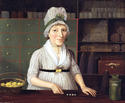 The mechanisation of cotton production in Glasgow ensured that fabric became cheap and easily available. Being washable it was an ideal fabric for clothing and, although lustrous silks continued to be worn, cotton became fashion's favourite. Dying and printing also quickly improved enabling calico printers to produce a wide range of colourful patterned fabrics at reasonable cost. Therefore with many workers earning money for the first time, especially factory workers, fashionable dress came within reach of many more Glasgow citizens. However working dress was of more serviceable hard-wearing fabric such as locally woven striped woollen cloth known as "drugget" and there continued to be a thriving trade in second-hand clothes in the Saltmarket.
The mechanisation of cotton production in Glasgow ensured that fabric became cheap and easily available. Being washable it was an ideal fabric for clothing and, although lustrous silks continued to be worn, cotton became fashion's favourite. Dying and printing also quickly improved enabling calico printers to produce a wide range of colourful patterned fabrics at reasonable cost. Therefore with many workers earning money for the first time, especially factory workers, fashionable dress came within reach of many more Glasgow citizens. However working dress was of more serviceable hard-wearing fabric such as locally woven striped woollen cloth known as "drugget" and there continued to be a thriving trade in second-hand clothes in the Saltmarket.
 Until the late 18th century children were generally dressed as adults, but with the Classical Revival a new simpler style was introduced first in children's dress and then women's. This simplification was also apparent in men's clothing as lace and silk brocade were replaced by plain white linen and well-cut, fine woollen cloth.
Until the late 18th century children were generally dressed as adults, but with the Classical Revival a new simpler style was introduced first in children's dress and then women's. This simplification was also apparent in men's clothing as lace and silk brocade were replaced by plain white linen and well-cut, fine woollen cloth.
 The classically inspired muslin gowns of the 1790s gave way to a more romantic fussy silhouette in the 1820s and 1830s and although initially worn in imitation of classical drapery, shawls not only continued to be worn, but to grow in popularity. More usually associated with the nearby town of Paisley, shawls were also made in Glasgow, particularly printed designs. Both shawls and the trimmings demanded by more decorative fashions were supplied by an increasing number of specialist shops.
The classically inspired muslin gowns of the 1790s gave way to a more romantic fussy silhouette in the 1820s and 1830s and although initially worn in imitation of classical drapery, shawls not only continued to be worn, but to grow in popularity. More usually associated with the nearby town of Paisley, shawls were also made in Glasgow, particularly printed designs. Both shawls and the trimmings demanded by more decorative fashions were supplied by an increasing number of specialist shops.